Massachusetts
state, United States
Introduction
Massachusetts, flag of

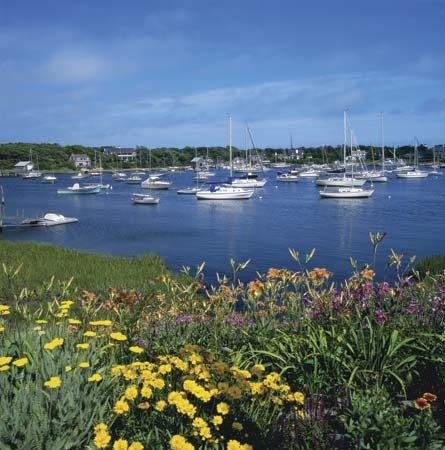 constituent state of the United States of America (United States). It was one of the original 13 states and is one of the 6 New England states lying in the northeastern corner of the country. Massachusetts (officially called a commonwealth) is bounded to the north by Vermont and New Hampshire, to the east and southeast by the Atlantic Ocean, to the south by Rhode Island and Connecticut, and to the west by New York. It is the sixth smallest of the U.S. states in area. The capital is Boston. English explorer and colonist John Smith (Smith, John) named the state for the Massachuset tribe, whose name meant “near the great hill”—believed to refer to Blue Hill, which rises south of Boston in an otherwise flat area. Massachusetts's residents represent an amalgamation of the prototypical Yankee spirit of an earlier America and the energies of the later immigrants who flocked to its cities in the 19th and 20th centuries.
constituent state of the United States of America (United States). It was one of the original 13 states and is one of the 6 New England states lying in the northeastern corner of the country. Massachusetts (officially called a commonwealth) is bounded to the north by Vermont and New Hampshire, to the east and southeast by the Atlantic Ocean, to the south by Rhode Island and Connecticut, and to the west by New York. It is the sixth smallest of the U.S. states in area. The capital is Boston. English explorer and colonist John Smith (Smith, John) named the state for the Massachuset tribe, whose name meant “near the great hill”—believed to refer to Blue Hill, which rises south of Boston in an otherwise flat area. Massachusetts's residents represent an amalgamation of the prototypical Yankee spirit of an earlier America and the energies of the later immigrants who flocked to its cities in the 19th and 20th centuries.


 constituent state of the United States of America (United States). It was one of the original 13 states and is one of the 6 New England states lying in the northeastern corner of the country. Massachusetts (officially called a commonwealth) is bounded to the north by Vermont and New Hampshire, to the east and southeast by the Atlantic Ocean, to the south by Rhode Island and Connecticut, and to the west by New York. It is the sixth smallest of the U.S. states in area. The capital is Boston. English explorer and colonist John Smith (Smith, John) named the state for the Massachuset tribe, whose name meant “near the great hill”—believed to refer to Blue Hill, which rises south of Boston in an otherwise flat area. Massachusetts's residents represent an amalgamation of the prototypical Yankee spirit of an earlier America and the energies of the later immigrants who flocked to its cities in the 19th and 20th centuries.
constituent state of the United States of America (United States). It was one of the original 13 states and is one of the 6 New England states lying in the northeastern corner of the country. Massachusetts (officially called a commonwealth) is bounded to the north by Vermont and New Hampshire, to the east and southeast by the Atlantic Ocean, to the south by Rhode Island and Connecticut, and to the west by New York. It is the sixth smallest of the U.S. states in area. The capital is Boston. English explorer and colonist John Smith (Smith, John) named the state for the Massachuset tribe, whose name meant “near the great hill”—believed to refer to Blue Hill, which rises south of Boston in an otherwise flat area. Massachusetts's residents represent an amalgamation of the prototypical Yankee spirit of an earlier America and the energies of the later immigrants who flocked to its cities in the 19th and 20th centuries.Massachusetts is unique among states because its history and culture predate and epitomize the experiences of the country as a whole. It is commonly known that the Puritan (Puritanism)s and Pilgrim (Pilgrim Fathers)s set the stage for eventual liberty of religious belief when they fled an oppressive government to settle in the New World. With such documents as the Mayflower Compact (1620) and the Body of Liberties (1641), an early code of law, they provided the basis for the concept that governments should rule by consent of the governed and with guarantees to protect individual expression.
These notions of individual liberty came into conflict with the colonies' status as part of the British Empire. The American Revolution originated in Massachusetts with the first resistance against British colonial rules. It was in Massachusetts that the colonists raised the hue and cry against taxation without representation, as exemplified by the Boston Tea Party; the activism of the Massachusetts colonists inspired others and culminated in the “shot heard round the world” at the Battles of Lexington and Concord (Lexington and Concord, Battles of) in 1775.
Massachusetts was in the vanguard when the new country began transforming itself from an agrarian to an industrial economy. The state's merchants, such as Francis Cabot Lowell (Lowell, Francis Cabot), whose fortunes depended on trade, sought safer investments after severe losses during the War of 1812. Textile, boot, and machinery manufacturing began in Massachusetts (and Rhode Island) and set the groundwork for the eventual industrialization and urbanization of the northeastern states. Farmers and their sons and daughters trekked to the new cities; by the mid-1870s, Massachusetts had become the first state in the Union in which more people lived in towns and cities than in rural areas.
Throughout the 19th century, Massachusetts was a leading manufacturing centre. Southern competition in the first half of the 20th century led to a massive economic decline, resulting in the closing of factories throughout the state. But World War II and the Cold War created new high-technology industries that depended on federal largesse in the form of defense spending. Meanwhile, service activities such as finance, education, and health care expanded, helping to create a new economy with Boston as its centre. In 2004 Massachusetts became the first state to legalize same-sex marriage; the law pointed out that excluding certain citizens from a valued institution was incompatible with the principles of individual autonomy and legal equality. Massachusetts's long struggle to maintain individual liberty while paying attention to communal needs resulted in the coalition of democratic principles and capitalist drives that are the hallmark of the United States. Area 8,263 square miles (21,401 square km). Pop. (2000) 6,349,097; (2007 est.) 6,449,755.
Land (Massachusetts)
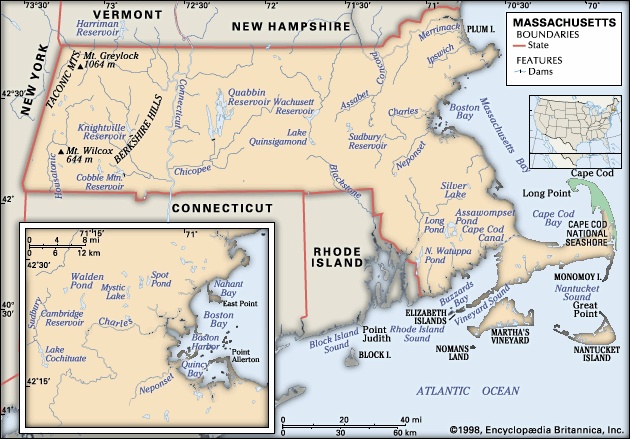
 The Massachusetts coastline is about 1,500 miles (2,400 km) in length, yet the cross-country distances are only 190 miles (310 km) from east to west and 110 miles (180 km) from north to south. The coast—whose configuration marked by numerous embayments gave rise to Massachusetts's nickname, the Bay State—winds from Rhode Island around Cape Cod (Cod, Cape), in and out of scenic harbours along the shore south of Boston, through Boston Harbor and up the North Shore, swinging around the painters' paradise of Cape Ann (Ann, Cape) to New Hampshire.
The Massachusetts coastline is about 1,500 miles (2,400 km) in length, yet the cross-country distances are only 190 miles (310 km) from east to west and 110 miles (180 km) from north to south. The coast—whose configuration marked by numerous embayments gave rise to Massachusetts's nickname, the Bay State—winds from Rhode Island around Cape Cod (Cod, Cape), in and out of scenic harbours along the shore south of Boston, through Boston Harbor and up the North Shore, swinging around the painters' paradise of Cape Ann (Ann, Cape) to New Hampshire.Relief
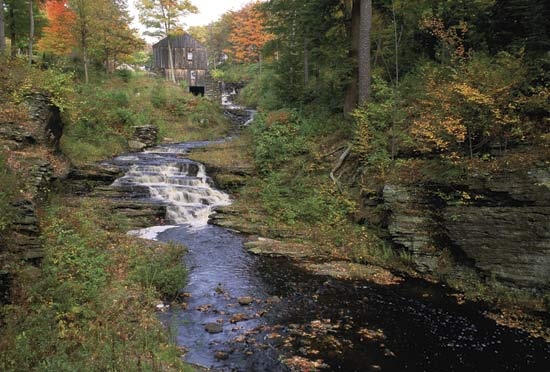 The indented coast of Massachusetts was formed by the great glaciers that in some places covered the land with several thousand feet of ice. When the last ice disappeared some 11,000 years ago, massive chunks of rocks were exposed along the shore. Hard, flat land stretches out beyond, becoming stony upland pastures near the central part of the state and a gently hilly country in the west. Except toward the west, the land is rocky, often sandy, and not fertile.
The indented coast of Massachusetts was formed by the great glaciers that in some places covered the land with several thousand feet of ice. When the last ice disappeared some 11,000 years ago, massive chunks of rocks were exposed along the shore. Hard, flat land stretches out beyond, becoming stony upland pastures near the central part of the state and a gently hilly country in the west. Except toward the west, the land is rocky, often sandy, and not fertile.In the southeast, Cape Cod (Cod, Cape) juts out into the ocean, forming Cape Cod Bay. This 65-mile- (105-km-) long appendage is rectangular in shape except at its easternmost point, where it hooks northward. Its offshore waters are among the most treacherous in the country. Tufts of grass spring up along the sand dunes, and gnarled jack pines and scrub oaks, some only head high, grow in bunches. Off the southeastern coast lie the islands of Nantucket and Martha's Vineyard, lashed by the gray Atlantic in winter but in summer alive with thousands of tourists and longtime seasonal residents.
Central Massachusetts comprises rolling plains fed by innumerable streams. Beyond lie the broad and fertile Connecticut River valley and the Berkshire Hills. The now-paved Mohawk Trail crosses the Berkshires—the Hoosac Range on the east and the Taconic Range on the west. The state's highest point, 3,491 feet (1,064 metres), is Mount Greylock (Greylock, Mount), on the Taconic side near Adams. In North Adams a natural bridge of white marble has been formed by the wind and water, and at nearby Sutton is a short gorge that knifes through the rock, exposing some 600 million years of geologic history.
Drainage
The land is veined with rivers—19 main systems, the most notable of which are the Connecticut (Connecticut River), Charles (Charles River), and Merrimack (Merrimack River). More than 1,100 ponds and lakes lie among the hollows of the hills; there is a body of water in almost every one of the more than 350 communities. Many bear long Indian names, most notably Lake Chaubunagungamaug (in Webster), the long form of which is Lake Chargoggagoggmanchauggauggagoggchaubunagungamaugg. The best-known small body of water, however, is Walden Pond, immortalized by writer and philosopher Henry David Thoreau (Thoreau, Henry David).
The Boston metropolitan area gets its drinking water from Quabbin Reservoir in the western part of the state. The world's largest man-made domestic water supply, it was built between 1933 and 1939 and required the displacement of 2,500 people and four towns (Dana, Enfield, Greenwich, and Prescott) to provide water for dozens of towns and cities to the east.
Climate
The state has a temperate climate. The climate is colder but drier in western Massachusetts, although its winter snowfalls may be more severe than those nearer the coast. July is the hottest month, averaging about 71 °F (22 °C), in contrast to 26 °F (−3 °C) in January, the coldest month. Annual precipitation averages 42 inches (1,070 mm) in Boston and 44 to 45 inches (1,120 to 1,140 mm) in Worcester and Pittsfield, in the central and western parts of the state, respectively.
Plant and animal life
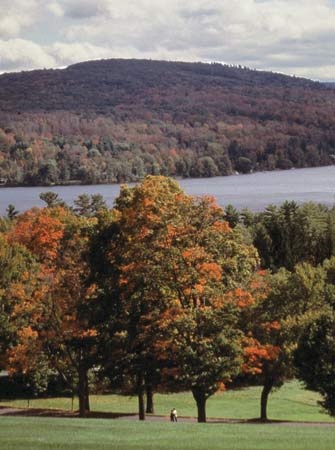 Despite its industrialization, Massachusetts has preserved many of its forests, and there are now nearly 150 state forests, reservations, and parks. Public hunting grounds amount to some 40 square miles (100 square km). About a dozen national wildlife refuges and the Cape Cod National Seashore allow further contact with nature. Not far from downtown Boston is the Arnold Arboretum of Harvard University, which opened to the public in 1872 and has one of the largest collections of trees and shrubs in the United States.
Despite its industrialization, Massachusetts has preserved many of its forests, and there are now nearly 150 state forests, reservations, and parks. Public hunting grounds amount to some 40 square miles (100 square km). About a dozen national wildlife refuges and the Cape Cod National Seashore allow further contact with nature. Not far from downtown Boston is the Arnold Arboretum of Harvard University, which opened to the public in 1872 and has one of the largest collections of trees and shrubs in the United States.Few large animals remain in the wild, but an occasional bear or moose is sighted. Other animals seen in the woods include deer, beavers, muskrats, minks, otters, snowshoe hares, red foxes, woodchucks, raccoons, and chipmunks. Along the shores sandpipers, blue herons, American egrets, sanderlings, and turnstones can be seen. Waterbirds include gulls, scoters, cormorants, and loons; those most often seen on land are kingfishers, warblers, bobwhites, brown thrashers, sparrow hawks, yellow-shafted flickers, and whippoorwills. Game birds include ruffed grouse, wild turkeys, and pheasant.
People (Massachusetts)
Population composition
Paleo-Indian hunter-gatherers had reached southern New England by some 10,000 years ago. By about AD 1000 the local inhabitants were Algonquian-speaking peoples who used horticultural techniques, as well as hunting, to create thriving societies. In the 17th century, land-hungry English settlers began to force out the Native Americans, and a great many native peoples also succumbed to European diseases. These Protestant English colonists, or “Yankees (Yankee),” as they were known, became the dominant population for more than 200 years.
In the 1840s the homogeneous Yankee society was inundated by waves of Roman Catholic Irish escaping the ravages of the Irish Potato Famine. Similarly, in the 1860s agricultural poverty in Canada sent French Canadians in large numbers to Massachusetts as workers in the new factory system pioneered by Yankee entrepreneurs. While severe conflict and hostility arose between Yankee and immigrant, the increasing industrial prosperity of the 19th century served to ameliorate these conflicts. By the 1890s, and up through the first decades of the 20th century, new immigrants from Italy, Portugal, Greece, and eastern Europe had arrived to work in the still-prosperous factories of the state. By 1920 two-thirds of the population were either immigrants or children of immigrants, leaving the Yankees a distinct minority. Immigration was severely curtailed, however, by the passage in 1924 of the federal Immigration (National Origins) Act.
In the late 1950s, African Americans from the South began to trek north, with many settling in towns and cities in Massachusetts. A change in immigration laws beginning in 1965 spurred new groups of immigrants to the state seeking work and a better life. The major newcomers included Asians, Latinos, West Indians, and Russians. This wave of immigration added to the ethnic variety of the state and changed the face of many communities.
Native Americans make up only a small proportion of Massachusetts (Massachuset)'s population today, although their ancestors' legacy remains in the state's name itself and in the names of dozens of its physical features.
Settlement patterns
 The earliest European settlements were along the seacoast, with the population most heavily concentrated in those towns that lay at the mouths of rivers. The settlers fanned inland along these streams, drawing on them at first for farm use and later for the power to run mills. Early towns were also settled along the Connecticut River in the western part of the state.
The earliest European settlements were along the seacoast, with the population most heavily concentrated in those towns that lay at the mouths of rivers. The settlers fanned inland along these streams, drawing on them at first for farm use and later for the power to run mills. Early towns were also settled along the Connecticut River in the western part of the state.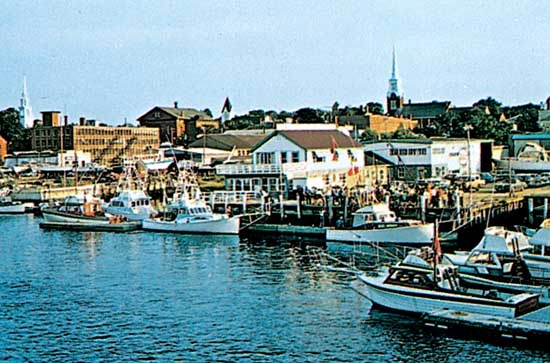 Today the lure of the sea results in nearly equal popularity for all of the towns along the coast, where sunbathing, swimming, yachting, and fishing are a way of life. Besides those on Cape Cod, among these coastal towns are Plymouth, with its long harbour; Duxbury, Marshfield, Scituate, and Cohasset, the first suburbs of Boston to spring up during colonial days; Hingham, with its boating bays; Revere and Lynn, known for their beaches; Marblehead, one of the great yachting capitals of the world; and Gloucester and Cape Ann, famous for fishing.
Today the lure of the sea results in nearly equal popularity for all of the towns along the coast, where sunbathing, swimming, yachting, and fishing are a way of life. Besides those on Cape Cod, among these coastal towns are Plymouth, with its long harbour; Duxbury, Marshfield, Scituate, and Cohasset, the first suburbs of Boston to spring up during colonial days; Hingham, with its boating bays; Revere and Lynn, known for their beaches; Marblehead, one of the great yachting capitals of the world; and Gloucester and Cape Ann, famous for fishing.Boston is surrounded by numerous bedroom communities, such as Belmont, Brookline, Malden, Milton, and Newton. Other urban centres include Springfield, Worcester, Fall River– New Bedford, Lowell- Lawrence, Pittsfield, and Fitchburg. These cities, which grew large during the Industrial Revolution, have since declined in population.
Religious heritage
Massachusetts is now largely Roman Catholic, though its religious foundation was solidly Protestant. The Pilgrims (Pilgrim Fathers), who established the Plymouth colony in 1620, and the Puritan (Puritanism) settlers went to Massachusetts mainly for religious reasons. Religion continued to be important throughout the early development of Massachusetts. The Puritan Congregational Church remained the established church until an amendment to the state constitution was passed in 1833. Following colonial patterns, churches often are found in the most prominent places of the towns and villages, symbolizing their traditional central role in social life.
Social hierarchies
Despite the great variety of ethnicities and national origins among the state's people, the major concentration of wealth and power continues to be controlled by the 800 or so families who trace their pedigrees to the Mayflower and by those who in the following centuries so successfully trod the avenues of commerce, finance, and culture that they came to be considered among the ranks of that still-relevant cadre, the “Proper Bostonians.” In the state's small towns too, a large proportion of the residents can claim a Yankee background going back many generations. Many descendants of later immigrants also have found their way to the top of the financial—and often political—ladder.
Economy
The economy of Massachusetts today is based largely on technological research and development and the service sector (including tourism). This represents a major shift from the state's preindustrial agricultural basis and maritime trade in the 17th and 18th centuries and the heavy manufacturing that characterized the 19th century and the first half of the 20th.
Fishing (commercial fishing) and agriculture
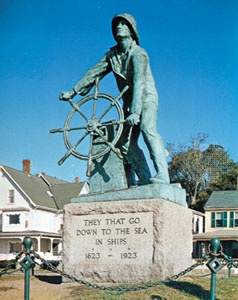 Foreign trade, fishing, and agriculture long buoyed the economy. Salem sailors brought exotic goods from China, the West Indies, and other faraway lands. Fishing was lucrative, adventurous, and dangerous; more than 10,000 fishermen from Gloucester alone have lost their lives over the centuries. Fishing and shipbuilding went hand in hand. Between 1789 and 1810 the Massachusetts fleet grew 10-fold, some of it to aid in defense against British and French aggressions on the high seas. Many Yankee sailors also worked in the slave trade between West Africa and Southern ports.
Foreign trade, fishing, and agriculture long buoyed the economy. Salem sailors brought exotic goods from China, the West Indies, and other faraway lands. Fishing was lucrative, adventurous, and dangerous; more than 10,000 fishermen from Gloucester alone have lost their lives over the centuries. Fishing and shipbuilding went hand in hand. Between 1789 and 1810 the Massachusetts fleet grew 10-fold, some of it to aid in defense against British and French aggressions on the high seas. Many Yankee sailors also worked in the slave trade between West Africa and Southern ports.At the height of the whaling boom in the 19th century, 329 whaling vessels sailed from New Bedford, in addition to others from Nantucket and other ports, bringing in cargo of enormous value each year. This great industry was not to last, however; by the turn of the 20th century, its contribution to the state's economy had dwindled to only a fraction of its former importance. Fishing later suffered substantial reverses as well. A booming business up to the early 1960s, fishing began to wane late in the decade because of foreign competition in the traditional Atlantic fishing grounds and the depletion from overfishing of such species as haddock and lobster. By the late 1970s, however, the industry had made a comeback; Massachusetts now usually ranks as one of the top U.S. states in value of fish landings.
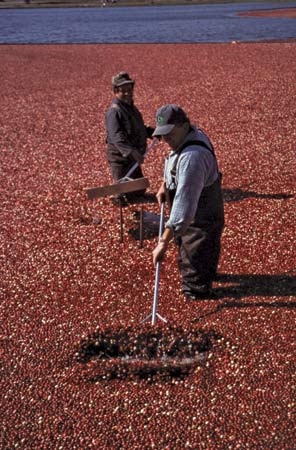 The generally rocky soils support only truck gardening, although the purple sandy bogs of southeastern Massachusetts and Cape Cod produce about two-fifths of the U.S. cranberry supply. Cranberries are one of the state's top sources of farm income, after greenhouse and nursery products. Dairy products are also important.
The generally rocky soils support only truck gardening, although the purple sandy bogs of southeastern Massachusetts and Cape Cod produce about two-fifths of the U.S. cranberry supply. Cranberries are one of the state's top sources of farm income, after greenhouse and nursery products. Dairy products are also important.Manufacturing, trade, and other services
The maritime trade dominated Massachusetts's economy for 200 years because of the state's poor agriculture. “Massachusetts went to sea…not of choice, but of necessity,” wrote historian Samuel Eliot Morison (Morison, Samuel Eliot) in The Maritime History of Massachusetts (1921). Also of importance to Massachusetts sailors was the West Indies trade, a paramount market for New England goods. It was from the profits of the maritime trade that great fortunes were made by families who became known as the Brahmins. After the War of 1812, these merchant families used their profits as capital to bring the Industrial Revolution to the state.
Massachusetts had had some manufacturing since the early 1640s. Francis Cabot Lowell (Lowell, Francis Cabot) was largely responsible, however, for raising the state to its manufacturing eminence. Lowell went to England to study methods of textile operations and, after his return, built a power loom in Waltham in 1814. He died in 1817, but his associates developed Lowell, the country's first planned industrial town, with its mills driven by the Merrimack River.
Yankee ingenuity fostered much early handicraft-based industry, though the influx of unskilled, low-paid labourers from Europe during the 19th century was the necessary ingredient for the mass production that developed in the state's shoe and textile factories. One of the first and largest shoe plants in the United States was the United Shoe Machinery Corporation in Beverly (built 1903–06), while the building of the Springfield armoury in 1777 boosted industry in western Massachusetts at the same time that it aided the Revolutionary cause. Other well-known goods from Massachusetts factories included watches from Waltham, Salem, and Boston; rocking chairs from Gardner; cutlery and hand tools from Greenfield; guns and motorcycles from Springfield; leather goods from Peabody; shovels (which were used by the “Forty-niners” during the California Gold Rush) from North Eaton; envelopes from Worcester; paper from Holyoke; silverware from Newburyport; and razor blades from Boston.
After manufacturing—particularly the textile and shoe factories—fell on hard times, high-technology industries and the service sector developed after 1950. By the early 21st century, Massachusetts's economy was prospering because of the close relationship between the computer and the communications industries, as well as the many educational institutions of the metropolitan Boston area. Several factors ensured a profitable and productive economic system: less reliance on defense contracts; continued success in exports of high-technology equipment, minicomputers, and semiconductors; ongoing investments by venture capitalists; and the availability of a highly educated workforce. Telecommunications and biotechnology also grew in importance.
The growth of other services—finance law, education, insurance, and health care—also contributed substantially to the state's financial well-being, especially because these activities were relatively well insulated from the caprice of consumer demand.
Transportation
Symbolic of Massachusetts's close relation to the sea, the first lighthouse in the United States, Boston Light, was built off that busy port in 1716, and graceful clipper ships (clipper ship) were built there from 1850 to 1856.
Waterways formed the Bay State's highway system for 200 years. Rivers such as the Connecticut and Merrimack and man-made canals such as the Middlesex served early needs well. The Boston Post Road and the Mohawk Trail were the most heavily traveled of the early roadways. Opened to Boston–New York mail in 1673, the Post Road consisted of three routes. The Mohawk, a Native American footpath that was converted to an ox road by the settlers, became the first interstate toll-free road, called Shunpike, in 1786.
In 1826 the country's first railroad carried granite from the quarries of Quincy and Charlestown for the building of the Bunker Hill Monument in Charlestown. The cars were horse drawn. A steam railroad connected Springfield and Worcester in 1839, and 15 systems were shuttling freight among western Massachusetts cities by 1855. Among the most notable feats of early railroad building was the 4.75-mile (7.6-km) Hoosac Tunnel, drilled under the Hoosac Range between 1851 and 1875. The first electric street railway was built in Brockton, and Boston had the country's first passenger subway, as well as an elevated system. Boston's Logan International Airport, stretching parallel to the harbour, is one of the few large air terminals in close proximity to a major city.
Government and society
Constitutional framework
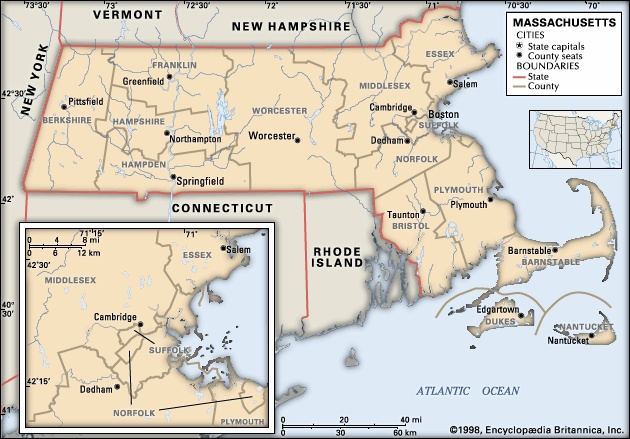
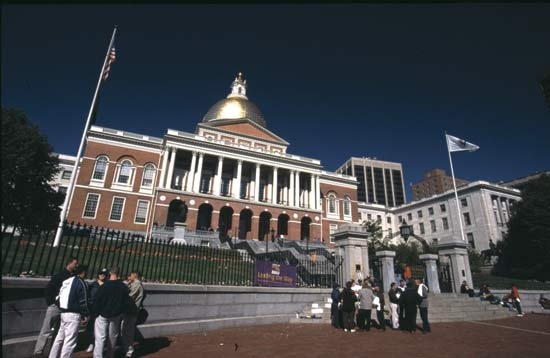
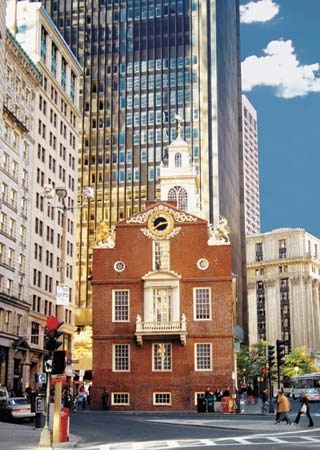 The Pilgrims established a government of sorts under the Mayflower Compact of 1620, which enshrined the notion of the consent of the governed. Next, in 1630, the Puritans used the royal charter establishing the Massachusetts Bay Company to create a government in which “freemen”—white males who owned property and paid taxes and thus could take on the responsibility of governing—elected a governor and a single legislative body called the Great and General Court, made up of assistants and deputies. Conflicts arose over the arbitrariness of the assistants, and in 1641 the legislature created the Body of Liberties. This document was a statement of principles for governance that protected individual liberties and was the basis for the guarantees later expressed in the Bill of Rights (Rights, Bill of) of the U.S. Constitution. In 1644 this single body became an entity made up of two chambers: the House of Assistants (later the Senate) and the House of Deputies (later the House of Representatives). This set the precedent of bicameralism for most governmental legislatures in the United States, including the eventual federal legislature.
The Pilgrims established a government of sorts under the Mayflower Compact of 1620, which enshrined the notion of the consent of the governed. Next, in 1630, the Puritans used the royal charter establishing the Massachusetts Bay Company to create a government in which “freemen”—white males who owned property and paid taxes and thus could take on the responsibility of governing—elected a governor and a single legislative body called the Great and General Court, made up of assistants and deputies. Conflicts arose over the arbitrariness of the assistants, and in 1641 the legislature created the Body of Liberties. This document was a statement of principles for governance that protected individual liberties and was the basis for the guarantees later expressed in the Bill of Rights (Rights, Bill of) of the U.S. Constitution. In 1644 this single body became an entity made up of two chambers: the House of Assistants (later the Senate) and the House of Deputies (later the House of Representatives). This set the precedent of bicameralism for most governmental legislatures in the United States, including the eventual federal legislature.At first the right to vote was limited to the “chosen”—those whose religious background was thought to ensure salvation—but, after the original charter was revoked and a new one established in 1691, the franchise was extended to property owners and taxpayers. The successful outcome of the American Revolution did much to further broaden the franchise in Massachusetts and establish a more democratic form of government, embodied in the constitution of 1780. Written by patriot and second U.S. president John Adams (Adams, John), that document installed a government of an executive and a two-tier General Court (legislature) to be elected by property owners and taxpayers. Many of its features were subsequently incorporated directly into the federal Constitution. Eventually, amendments granted all men and women the right to vote and hold office. Today, Massachusetts is the only one of the 13 original states still governed under its first constitution, which is the oldest governing constitution in the world. It has, however, been amended many times.
The houses of the General Court comprise 40 senators and 160 representatives, respectively; members of each house serve two-year terms. The Supreme Judicial Court is the state's highest court. Below it are the Appeals Court and various trial court departments, including those of the superior courts (which conduct felony jury trials) and district courts. Justices are appointed by the governor with the approval of the Governor's Council, a group of eight advisers elected annually by the General Court.
Another political institution that emerged shortly after the settlers arrived was the town meeting, which started as a forum for settling local quarrels and grew to what is in many smaller towns the community event of the year. (As the poet and critic James Russell Lowell (Lowell, James Russell) observed, “ Puritanism, believing itself quick with the seed of religious liberty, laid, without knowing it, the egg of democracy.”) The first recorded meeting was in Dorchester in 1633, when citizens were summoned by the roll of a drum. A year later Charlestown organized the first board of selectmen, the emergence of such local government balancing the power of the colony's executive. A county system was patterned after the English model, in which the greater powers reside in townships and cities rather than in the counties. The county system was further weakened by the legislature in 1999 when 6 of the 13 county governments were abolished because of debts or mismanagement of funds.
Massachusetts politics were long dominated by the Republican Party—from after the Civil War until 1952. Fueled by the massive Irish immigration of the 1840s and '50s, the Democratic Party slowly broke the Republican monopoly on local political offices at the turn of the 20th century, but it took almost 50 years for the growing immigrant majority to put power more completely in Democratic hands. The reversal came to be near-complete, and, from the mid-20th century, Democrats dominated both houses of the legislature; however, factionalism within the party tended to allow Republicans to dominate the governorship. During the late 19th and early 20th centuries, politics became a means to a better life—to a place alongside the Boston Brahmins of Mayflower heritage—for the Irish and other immigrant groups who experienced great discrimination and hostility. In 1881 Lawrence became the first major city to elect an Irish Catholic mayor; Boston followed suit in 1884. The Boston Irish politician has become legendary, mostly because of James Michael Curley (Curley, James Michael), who served as mayor, governor, and U.S. representative at various times from 1914 to 1950. A skillful orator from a poor background, Curley, though twice jailed (once while in office), retained the popular support of the working-class electorate.
The state has played an important role in national politics. It has contributed five presidents—Adams and his son John Quincy Adams (Adams, John Quincy), Calvin Coolidge (Coolidge, Calvin), John F. Kennedy (Kennedy, John F.), and George H.W. Bush (Bush, George)—as well as several presidential nominees and a great number of cabinet officers, career bureaucrats, diplomats, and congressional leaders.
Health and welfare
Massachusetts is one of the chief medical centres of the world, particularly in the area of specialists and specialty hospitals. It has also been a leader in research, notably at Boston's Dana-Farber Cancer Institute (formerly Children's Cancer Research Foundation) and Massachusetts General and Beth Israel Deaconess hospitals.
The state was an early leader in the fight to improve social conditions. Regulatory laws were passed, beginning in the early 19th century, to protect residents. State boards, under the supervision of the governor, later grew out of the need to improve conditions in health, education, welfare, labour, banking, insurance, and prisons. The state recognized its responsibility for the care of the mentally ill (mental hygiene) and other disabled citizens as early as 1818, when Massachusetts General Hospital opened an “asylum for the insane,” as it was then known. The first state almshouse opened in 1854, while the country's first public health hospital for tubercular patients began operations in 1898. Despite these early gains, care for the mentally ill, alcoholics, addicts, the homeless, and juvenile delinquents has remained a problem in the state, as it has nationwide.
Following colonial tradition, welfare remained the province of the municipalities until it was taken over by the state in 1970. Although the new program was fraught with difficulty, it was an improvement over the system that existed in the mid-19th century, when citizens were still imprisoned for debt. State programs now stress training and educating welfare recipients to help them to become self-sufficient.
Education
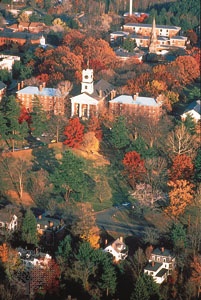 Education lies close to the heart of Massachusetts's social and cultural life. Harvard College (now Harvard University) was founded in 1636 in New Towne (now Cambridge). Although it was designed originally to provide the wilderness colony with a continuing supply of trained clergy rather than an educated lay population, its graduates became community leaders, and schooling soon was provided colonywide. In 1647 towns with at least 50 householders were required to support an elementary school; those with 100, a secondary school.
Education lies close to the heart of Massachusetts's social and cultural life. Harvard College (now Harvard University) was founded in 1636 in New Towne (now Cambridge). Although it was designed originally to provide the wilderness colony with a continuing supply of trained clergy rather than an educated lay population, its graduates became community leaders, and schooling soon was provided colonywide. In 1647 towns with at least 50 householders were required to support an elementary school; those with 100, a secondary school.Massachusetts became a pioneer as well in kindergarten and secondary education and developed a uniform state public-school system in 1840. The state has numerous private preparatory schools of national ranking. Roxbury Latin School, founded in 1645, is among the country's oldest.
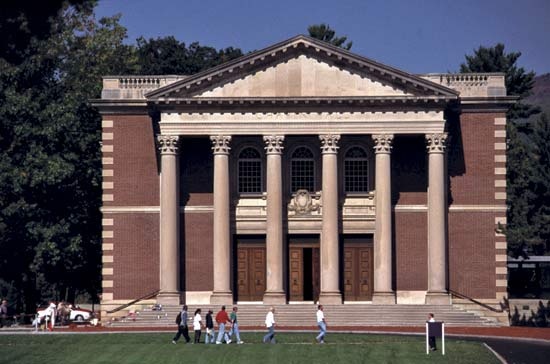 Many of the country's oldest and most prestigious institutions of higher learning, in addition to Harvard, are located in Massachusetts. The largest, both in Boston, are Boston University (1839) and Northeastern University (1898). Nearby are the Massachusetts Institute of Technology (Cambridge; 1861) and Tufts (Tufts University) (Medford; 1852) and Brandeis (Brandeis University) (Waltham; 1948) universities. Amherst (Amherst College) (Amherst; 1821) and Williams (Williams College) (Williamstown; 1793) colleges have perpetuated traditions of academic excellence at small schools, while Mount Holyoke (Mount Holyoke College) (South Hadley; 1837), Wellesley (Wellesley College) (Wellesley; 1870), Smith (Smith College) (Northampton; 1871), and Radcliffe (Cambridge; 1879) colleges have been pioneers in women's education; in 1999 Radcliffe formally merged with Harvard and ceased to exist as a college. Boston College (Chestnut Hill; 1863) and College of the Holy Cross (Holy Cross, College of the) (Worcester; 1843) are major Roman Catholic institutions. The University of Massachusetts (Massachusetts, University of), founded as a land-grant college in 1863, is the principal state university and has five campuses—Amherst (main), Dartmouth, Lowell, and Boston and the medical school in Worcester.
Many of the country's oldest and most prestigious institutions of higher learning, in addition to Harvard, are located in Massachusetts. The largest, both in Boston, are Boston University (1839) and Northeastern University (1898). Nearby are the Massachusetts Institute of Technology (Cambridge; 1861) and Tufts (Tufts University) (Medford; 1852) and Brandeis (Brandeis University) (Waltham; 1948) universities. Amherst (Amherst College) (Amherst; 1821) and Williams (Williams College) (Williamstown; 1793) colleges have perpetuated traditions of academic excellence at small schools, while Mount Holyoke (Mount Holyoke College) (South Hadley; 1837), Wellesley (Wellesley College) (Wellesley; 1870), Smith (Smith College) (Northampton; 1871), and Radcliffe (Cambridge; 1879) colleges have been pioneers in women's education; in 1999 Radcliffe formally merged with Harvard and ceased to exist as a college. Boston College (Chestnut Hill; 1863) and College of the Holy Cross (Holy Cross, College of the) (Worcester; 1843) are major Roman Catholic institutions. The University of Massachusetts (Massachusetts, University of), founded as a land-grant college in 1863, is the principal state university and has five campuses—Amherst (main), Dartmouth, Lowell, and Boston and the medical school in Worcester.Cultural life
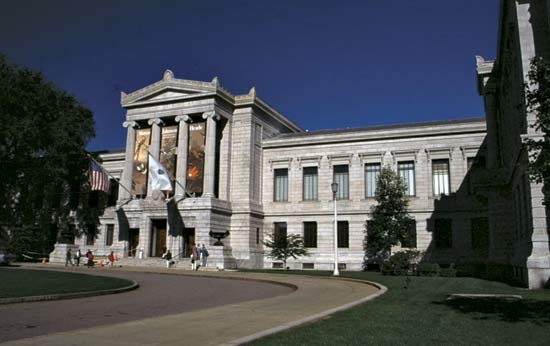
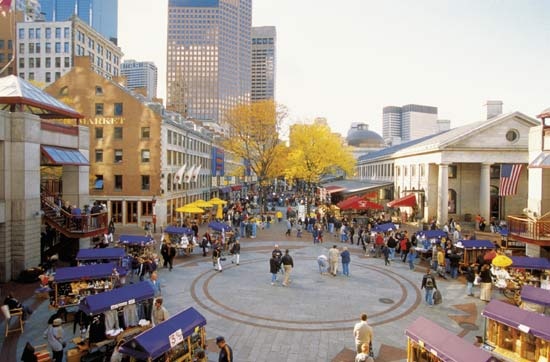 The blending of an Old World heritage and a New World spirit produced a bountiful cultural environment in Massachusetts. As scholar Perry Miller wrote in The New England Mind (1939), “Puritanism was one of the major expressions of Western intellect” and was “an important part of the whole thought of the seventeenth century.” The journals, sermons, and poetry of Puritans such as William Bradford (Bradford, William), John Winthrop (Winthrop, John), Cotton Mather (Mather, Cotton), John Cotton (Cotton, John), Anne Bradstreet (Bradstreet, Anne), and Edward Taylor (Taylor, Edward) erected major foundation blocks of the American character. Following in their footsteps were the brilliant writings of Jonathan Edwards (Edwards, Jonathan) and the delicate poetry of Phillis Wheatley (Wheatley, Phillis). During what has been called the American Renaissance, however, beginning around the time of the Revolution and lasting through much of the 19th century, the state nourished many writers who might be said to have formed the basis of American literature—and who brought it recognition outside the young country.
The blending of an Old World heritage and a New World spirit produced a bountiful cultural environment in Massachusetts. As scholar Perry Miller wrote in The New England Mind (1939), “Puritanism was one of the major expressions of Western intellect” and was “an important part of the whole thought of the seventeenth century.” The journals, sermons, and poetry of Puritans such as William Bradford (Bradford, William), John Winthrop (Winthrop, John), Cotton Mather (Mather, Cotton), John Cotton (Cotton, John), Anne Bradstreet (Bradstreet, Anne), and Edward Taylor (Taylor, Edward) erected major foundation blocks of the American character. Following in their footsteps were the brilliant writings of Jonathan Edwards (Edwards, Jonathan) and the delicate poetry of Phillis Wheatley (Wheatley, Phillis). During what has been called the American Renaissance, however, beginning around the time of the Revolution and lasting through much of the 19th century, the state nourished many writers who might be said to have formed the basis of American literature—and who brought it recognition outside the young country.The writers who brought fame to Concord are an indication of the inspiration of this period. A deep sense of both community responsibility and individualism may be traced through the writings of Ralph Waldo Emerson (Emerson, Ralph Waldo), Henry David Thoreau (Thoreau, Henry David), and Louisa May Alcott (Alcott, Louisa May), all of whom were neighbours. The Transcendentalist (Transcendentalism) movement, led by preacher, philosopher, and poet Emerson, who expounded his concepts of individual spiritual freedom, inspired deeper and darker revelations in the works of Nathaniel Hawthorne (Hawthorne, Nathaniel) and Herman Melville (Melville, Herman). Oliver Wendell Holmes (Holmes, Oliver Wendell) and Henry Wadsworth Longfellow (Longfellow, Henry Wadsworth) combined, respectively, medicine and scholarship with their writings. Among other famous writers of the era were John Greenleaf Whittier (Whittier, John Greenleaf), James Russell Lowell, and Emily Dickinson (Dickinson, Emily), who is generally acclaimed as one of the finest American poets of the 19th century.
The universities have become central to many of the performing arts in Massachusetts, and the Boston Symphony Orchestra generally is regarded as among the finest musical ensembles in the world. Its Tanglewood concerts at Lenox in the Berkshires (begun in 1938) are, with the Jacob's Pillow Dance Festival at nearby Becket, among the major attractions of the New England summer.
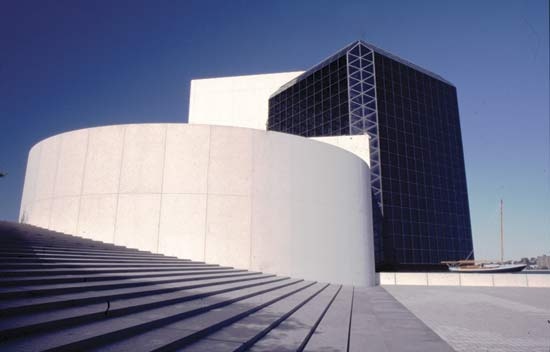 Boston's museums appeal to a variety of interests, ranging from the renowned collections of the Museum of Fine Arts, the Isabella Stewart Gardner Museum, the Computer Museum (now part of the Museum of Science), and the John F. Kennedy Museum and Library. Visitors with children often gravitate toward the Museum of Science, the New England Aquarium, and the Children's Museum, which pioneered the use of participatory exhibits. Important collections of historical records are held by the Massachusetts Historical Society, the Massachusetts Archives, the Boston Athenaeum, the Boston Public Library, and the New England Historic Genealogical Society.
Boston's museums appeal to a variety of interests, ranging from the renowned collections of the Museum of Fine Arts, the Isabella Stewart Gardner Museum, the Computer Museum (now part of the Museum of Science), and the John F. Kennedy Museum and Library. Visitors with children often gravitate toward the Museum of Science, the New England Aquarium, and the Children's Museum, which pioneered the use of participatory exhibits. Important collections of historical records are held by the Massachusetts Historical Society, the Massachusetts Archives, the Boston Athenaeum, the Boston Public Library, and the New England Historic Genealogical Society.Historical sites in Boston draw many tourists. The Freedom Trail provides a trip that includes Boston Common, the old and new (1713 and 1798) state houses, Park Street Church, the Old Granary Burying Ground, the Old Corner Bookstore, Faneuil Hall, the Paul Revere House, the Old North Church, and the USS Constitution, better known as Old Ironsides.
Outside the capital the past seems still alive in three villages: Plimoth Plantation, Old Sturbridge Village, and Shaker Village in Hancock, where the sect established its communal-church concept in the 1780s. Harvard Square in Cambridge is a favourite tourist stop for its potpourri of people and its proximity to Harvard University and the Massachusetts Institute of Technology. Salem's House of Seven Gables and other “haunted” houses keep the memories of the witchcraft era alive.
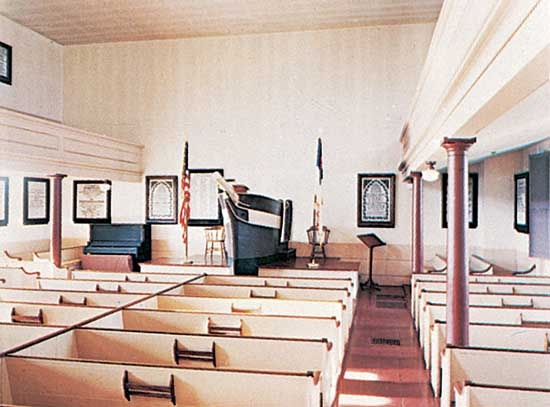 Along the South Shore are Quincy, where the humble homes of the eminent Adams family are located next door to one another, and Hingham, where the Old Ship Church is the oldest surviving church of the 13 colonies. The New Bedford Whaling Museum includes a half-size reproduction of a whaling vessel and some 600 logbooks; the Seamen's Bethel (chapel), also located in New Bedford, was immortalized by Melville in Moby Dick.
Along the South Shore are Quincy, where the humble homes of the eminent Adams family are located next door to one another, and Hingham, where the Old Ship Church is the oldest surviving church of the 13 colonies. The New Bedford Whaling Museum includes a half-size reproduction of a whaling vessel and some 600 logbooks; the Seamen's Bethel (chapel), also located in New Bedford, was immortalized by Melville in Moby Dick. West of Boston lies Concord with its Old Manse, home of the Emersons and, for four years, of the Hawthornes. Past the Old Mill and Longfellow's Wayside Inn in Sudbury are Worcester and then Springfield, where the armoury and arsenal are reminders of the city's famous rifle. In nearby Pelham the town hall complex has the oldest continuously used meetinghouse in the country and a monument to Capt. Daniel Shays (Shays, Daniel), who led a rebellion of poor farmers in 1786. Chesterwood in Stockbridge was the site of the studio of Daniel Chester French (French, Daniel Chester), sculptor of the great seated Lincoln statue in Washington, D.C.'s Lincoln Memorial. Some of the doors of houses in Old Deerfield bear the marks of Native American tomahawks wielded during the raids of the early 18th century.
West of Boston lies Concord with its Old Manse, home of the Emersons and, for four years, of the Hawthornes. Past the Old Mill and Longfellow's Wayside Inn in Sudbury are Worcester and then Springfield, where the armoury and arsenal are reminders of the city's famous rifle. In nearby Pelham the town hall complex has the oldest continuously used meetinghouse in the country and a monument to Capt. Daniel Shays (Shays, Daniel), who led a rebellion of poor farmers in 1786. Chesterwood in Stockbridge was the site of the studio of Daniel Chester French (French, Daniel Chester), sculptor of the great seated Lincoln statue in Washington, D.C.'s Lincoln Memorial. Some of the doors of houses in Old Deerfield bear the marks of Native American tomahawks wielded during the raids of the early 18th century.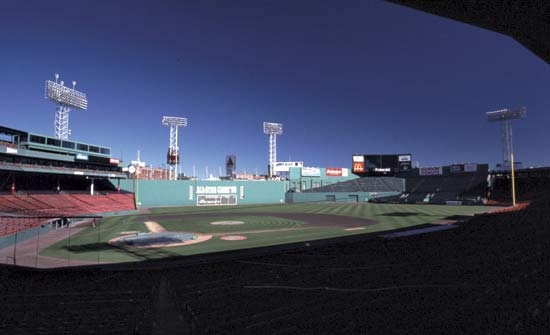 Athletics have come to form a subculture among all social classes. The professional teams—Boston's Red Sox in baseball, Bruins in ice hockey, and Celtics in basketball and the New England Patriots, based southeast of Boston, in gridiron football—attract the most attention, but the state also gives considerable emphasis to high-school and college athletics. The prestigious Boston Marathon, the world's oldest annual footrace, has been held since 1897 and attracts participants from all over the world.
Athletics have come to form a subculture among all social classes. The professional teams—Boston's Red Sox in baseball, Bruins in ice hockey, and Celtics in basketball and the New England Patriots, based southeast of Boston, in gridiron football—attract the most attention, but the state also gives considerable emphasis to high-school and college athletics. The prestigious Boston Marathon, the world's oldest annual footrace, has been held since 1897 and attracts participants from all over the world.History (Massachusetts)
Although the landing of the Pilgrims (Pilgrim Fathers) on Nov. 21, 1620, was important, Native American peoples had arrived in this corner of North America perhaps some 10,000 years before that, and Leif Eriksson (Leif Eriksson the Lucky) and his Norsemen may have landed somewhere in the Cape Cod region about 1003. European seafarers tapped the fertile fishing areas throughout the 1500s; the French explorer Samuel de Champlain (Champlain, Samuel de) mapped the area in 1605; and in 1614 Capt. John Smith (Smith, John) of the Virginia colony drafted a detailed map of the New England coast from Penobscot Bay in Maine to Cape Cod.
European settlement
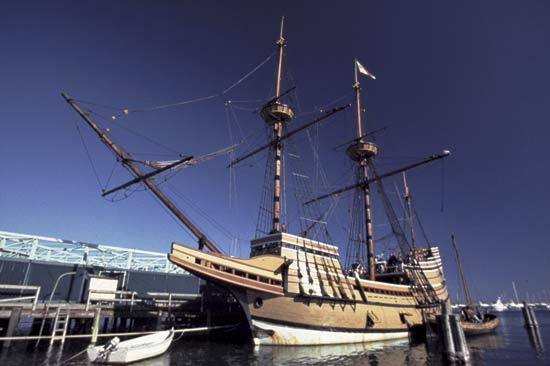 Prior to 1685 there were two separate colonies within the boundaries of present-day Massachusetts. The area around Plymouth and Cape Cod (Cod, Cape), settled by the Pilgrims, was known as Plymouth colony, or the Old Colony. By the mid-1640s its population numbered about 3,000 people. The colonists who traveled to the New World on the Mayflower were a small group of Separatists (Separatist) who had fled to Holland from England to practice their religion without official interference. Economic hardship and a desire to establish an identity free of Dutch influence prompted them to seek out America. The Pilgrims were never granted a royal charter; their government was based on the Mayflower Compact, a document signed by 41 male passengers on the Mayflower five weeks before their arrival in the New World. The compact was hardly democratic, since it called for rule by the elite, but it established an elective system and a basis for limited consent of the governed as the source of authority. The Old Colony was rapidly overshadowed by its Puritan neighbour to the north, the Massachusetts Bay Colony.
Prior to 1685 there were two separate colonies within the boundaries of present-day Massachusetts. The area around Plymouth and Cape Cod (Cod, Cape), settled by the Pilgrims, was known as Plymouth colony, or the Old Colony. By the mid-1640s its population numbered about 3,000 people. The colonists who traveled to the New World on the Mayflower were a small group of Separatists (Separatist) who had fled to Holland from England to practice their religion without official interference. Economic hardship and a desire to establish an identity free of Dutch influence prompted them to seek out America. The Pilgrims were never granted a royal charter; their government was based on the Mayflower Compact, a document signed by 41 male passengers on the Mayflower five weeks before their arrival in the New World. The compact was hardly democratic, since it called for rule by the elite, but it established an elective system and a basis for limited consent of the governed as the source of authority. The Old Colony was rapidly overshadowed by its Puritan neighbour to the north, the Massachusetts Bay Colony. Puritanism was persecuted in England because it sought ecclesiastical reform within the Church of England structure (rather than the Separatists' dissociation from it). They were not advocates of religious tolerance, as other Protestant groups and radical thinkers discovered. Many with differing religious views—including Roger Williams (Williams, Roger) of Salem and Anne Hutchinson (Hutchinson, Anne) of Boston, as well as unrepentant Quakers and Anabaptists—were banished, and a few were executed. The Massachusetts Bay Colony expanded rapidly. By the mid-1640s it numbered more than 20,000 people, and it began absorbing settlements in Maine and New Hampshire. The government of the colony was based on a providential interpretation of the royal charter granted by King Charles I, which was transferred to the new settlement by its governor, John Winthrop (Winthrop, John). The exhortation by Winthrop, “For wee must Consider that wee shall be as a Citty uppon a Hill, the eies of all people are uppon us,” underlines the strength of conviction of the Puritan mission.
The Puritans essentially established a theocracy, with close ties between the government and the clergy. The leaders felt comfortable not only in establishing patterns of government by interpreting the colony charter but also in interpreting the will of God for the people. However, the arrangement fell short of its purpose. When in 1634 Winthrop refused to call a meeting of the General Court, the freemen demanded to see the charter. He acceded, divulging his infringement on the rights of the legislature, and a bill was quickly passed that vested governmental power in the freemen.
The Puritan government often operated as an independent state, to the point of minting its own money and even conducting its own foreign affairs. Great Britain, after neglecting the colony for many years, revoked the company charter and in 1691 set up a royal colony that united Massachusetts with the former colonies of Plymouth and Maine and the islands of Nantucket and Martha's Vineyard. In this new Massachusetts, the franchise was given only to those who owned property or paid taxes. Continued lack of interference from Great Britain allowed the colonists to gain a tradition of self-reliance and self-government. Maine remained a part of Massachusetts until 1820, when it was established as a separate state.
Settlers feared the reputedly hostile Native Americans of Massachusetts, but until 1675 relative peace prevailed because of a pact with Massasoit, chief of the Wampanoag people. This accord was ended by Metacom (known to the English as King Philip), Massasoit's son. His open warfare, King Philip's War (1675–76), ended with his own death, but only after hundreds of settlers had been killed and some 50 towns raided in southeastern and central Massachusetts. Repeated expeditions against the Native Americans were common in the 18th century, as Massachusetts men joined with British troops to fight the French and their Indian allies.
Commercial and industrial expansion marked 18th-century Massachusetts and resulted in the rapid settlement of new communities, many spurred by speculation. Between 1692 and 1765, 111 new towns and districts were incorporated, while the population increased to 222,563.
Revolutionary period and statehood
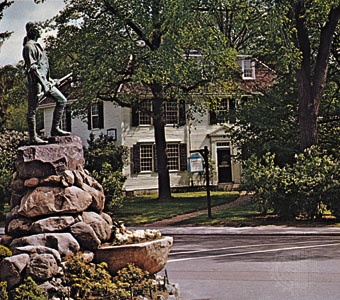 The opening shots of the American Revolutionary War (American Revolution) at the Battles of Lexington and Concord (Lexington and Concord, Battles of)—where the Massachusetts militia known as the minutemen (minuteman) faced their first battle—initiated a new order in Massachusetts and its sister provinces. The struggle had actually begun several years earlier, when a new spirit had emerged out of years of physical struggle and radical ideas involving such concepts as equality, freedom, and unity. Events in Boston—the fight against the writs of assistance (assistance, writ of), the Boston Massacre, the Boston Tea Party and resulting closure of the port of Boston, and the Battle of Bunker Hill (Bunker Hill, Battle of) and the later evacuation of the British troops from Boston—as well as in Lexington and Concord, inspired song and verse that came to typify the spirit of the Revolutionary era. Agrarian unrest in 1786–87 resulted in the only military threat to the new commonwealth; Gov. James Bowdoin (Bowdoin, James) was forced to call out a special state army of 4,400 men to suppress Shays's Rebellion. The unrest and fear generated by this armed insurrection probably helped advance support for the ratification of the new U.S. Constitution; a year later, in 1788, Massachusetts became the sixth state to ratify the Constitution (Constitution of the United States of America).
The opening shots of the American Revolutionary War (American Revolution) at the Battles of Lexington and Concord (Lexington and Concord, Battles of)—where the Massachusetts militia known as the minutemen (minuteman) faced their first battle—initiated a new order in Massachusetts and its sister provinces. The struggle had actually begun several years earlier, when a new spirit had emerged out of years of physical struggle and radical ideas involving such concepts as equality, freedom, and unity. Events in Boston—the fight against the writs of assistance (assistance, writ of), the Boston Massacre, the Boston Tea Party and resulting closure of the port of Boston, and the Battle of Bunker Hill (Bunker Hill, Battle of) and the later evacuation of the British troops from Boston—as well as in Lexington and Concord, inspired song and verse that came to typify the spirit of the Revolutionary era. Agrarian unrest in 1786–87 resulted in the only military threat to the new commonwealth; Gov. James Bowdoin (Bowdoin, James) was forced to call out a special state army of 4,400 men to suppress Shays's Rebellion. The unrest and fear generated by this armed insurrection probably helped advance support for the ratification of the new U.S. Constitution; a year later, in 1788, Massachusetts became the sixth state to ratify the Constitution (Constitution of the United States of America).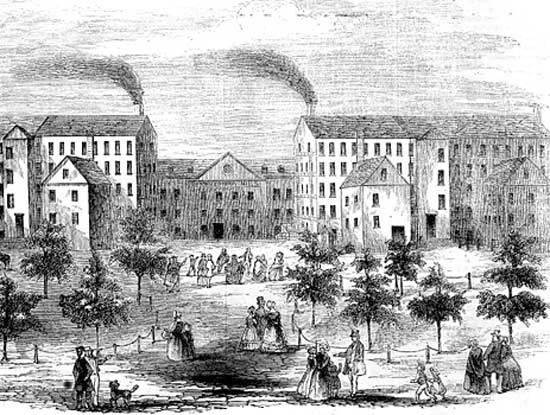 Massachusetts was in the forefront of the Industrial Revolution, and the resulting changes guaranteed that by the mid-19th century the state would be vastly different from its colonial antecedents. A decline in agricultural lands fostered both a migration away from Massachusetts and the development of large-scale manufacturing enterprises producing textiles, shoes, and machinery. The rural cast to the state was lost with the rise of a number of urban areas, connected by turnpikes, canals, and, later, railroads. The shattering of ethnic and religious homogeneity through immigrant migration, especially the arrival of the Irish, accentuated these changes. Property requirements were removed for voters; the Congregational (Congregationalism) Church was disestablished; black regiments from Massachusetts fought in the American Civil War; and Irish politicians began to be elected to public office. The population of Massachusetts continued to expand, although at a slower rate than the rest of the country, until by 1860 it had become the second most densely populated state.
Massachusetts was in the forefront of the Industrial Revolution, and the resulting changes guaranteed that by the mid-19th century the state would be vastly different from its colonial antecedents. A decline in agricultural lands fostered both a migration away from Massachusetts and the development of large-scale manufacturing enterprises producing textiles, shoes, and machinery. The rural cast to the state was lost with the rise of a number of urban areas, connected by turnpikes, canals, and, later, railroads. The shattering of ethnic and religious homogeneity through immigrant migration, especially the arrival of the Irish, accentuated these changes. Property requirements were removed for voters; the Congregational (Congregationalism) Church was disestablished; black regiments from Massachusetts fought in the American Civil War; and Irish politicians began to be elected to public office. The population of Massachusetts continued to expand, although at a slower rate than the rest of the country, until by 1860 it had become the second most densely populated state.Massachusetts since 1900
 The consequences of the Industrial Revolution—increasing urbanization, an economy based on manufacturing, and a large immigrant population of low-paid workers—had a major impact on Massachusetts in the 20th century. The most noticeable change was the shift of the textile and shoe industries out of Massachusetts to Southern and Midwestern states (and, eventually, largely overseas). Labour unrest, economic stagnation, and urban decay followed. The two world wars brought only brief respites from this decline. The advent of the electronics and communications industries after World War II finally brought this cycle to a halt. Aided by federal money for research and development, numerous small corporations began to draw on the expertise of academics from Boston and Cambridge.
The consequences of the Industrial Revolution—increasing urbanization, an economy based on manufacturing, and a large immigrant population of low-paid workers—had a major impact on Massachusetts in the 20th century. The most noticeable change was the shift of the textile and shoe industries out of Massachusetts to Southern and Midwestern states (and, eventually, largely overseas). Labour unrest, economic stagnation, and urban decay followed. The two world wars brought only brief respites from this decline. The advent of the electronics and communications industries after World War II finally brought this cycle to a halt. Aided by federal money for research and development, numerous small corporations began to draw on the expertise of academics from Boston and Cambridge.High-technology industry began as a suburban Boston phenomenon, but it also revitalized many of the state's larger cities, with their large abandoned mill complexes becoming home to numerous research-and-development firms. Along with that changeover came a dramatic rise in the service sector—notably in finance, education, and health—that made the state and its core service centre, Boston, the birthplace of the new national economy of the latter half of the 20th and beginning of the 21st centuries. A skilled and resilient labour force, combined with a powerful research-oriented higher-educational system and innovative venture capitalists, brought Massachusetts back to economic health. With a highly educated citizenry in place, it was an easy leap for Massachusetts to become a leader in biotechnology and the “information revolution” in the 1990s.
Since its beginning as an English colony and continuing through the Revolution and after, Massachusetts has been a leader in promoting democratic ideals. It has also been a national economic leader, providing cutting-edge innovations and technology. Such qualities have placed the national influence of the state, and of its native sons and daughters, above that of many other, larger states.
Additional Reading
Federal Writers' Project of the Works Progress Administration of Massachusetts, Massachusetts: A Guide to Its Places and People (1937, reprinted as The WPA Guide to Massachusetts, 1983), details many aspects of the state; an updated version was also published as Massachusetts: A Guide to the Pilgrim State, 2nd ed., rev. and enlarged (1971). Georgia Orcutt, Massachusetts: Portrait of the Land and Its People, 2 vol. (1988); and Richard W. Wilkie and Jack Tager (eds.), Historical Atlas of Massachusetts (1991), are historical geographies. Additional geographic information is available in DeLorme Mapping Company, Massachusetts Atlas & Gazetteer, 2nd ed. (2002).General historical works on Massachusetts and the larger New England region include Richard D. Brown and Jack Tager, Massachusetts: A Concise History (2000); Joseph A. Conforti, Imagining New England: Explorations of Regional Identity from the Pilgrims to the Mid-Twentieth Century (2001); John T. Cumbler, Reasonable Use: The People, the Environment, and the State, New England, 1790–1930 (2001); and Peter Temin (ed.), Engines of Enterprise: An Economic History of New England (2002). Useful collections are Henry F. Bedford (ed.), Their Lives and Numbers: The Condition of Working People in Massachusetts, 1870–1900 (1995); Susan L. Porter (ed.), Women of the Commonwealth: Work, Family, and Social Change in Nineteenth-Century Massachusetts (1996); Jack Tager and John W. Ifkovic (eds.), Massachusetts in the Gilded Age: Selected Essays (1985); Jack Tager, Michael Konig, and Martin Kaufman (eds.), Massachusetts Politics: Selected Historical Essays (1998); Martin Kaufman, John W. Ifkovic, and Joseph Carvalho III (eds.), A Guide to the History of Massachusetts (1988), a collection of nine historiographic essays, six of them on specific time periods; and Reed Ueda and Conrad Edick Wright (eds.), Faces of Community: Immigrant Massachusetts, 1860–2000 (2003). Proceedings of the Massachusetts Historical Society (annual) is a useful periodical. John D. Haskell, Jr. (ed.), Massachusetts: A Bibliography of Its History (1976, reprinted 1983), is an extensive work.
- Mývatn
- Mādhavācārya
- Mādhyamika
- Māhir, Aḥmad
- Māhir Pasha, ʿAlī
- Mālik ibn Anas
- Mālikī, Nūrī al-
- Mālikīyah
- Mālwa painting
- Mānsehra
- Mānyakheṭa
- Māra
- Māturīdī, Abū Manṣūr Muḥammad al-
- Māturīdīyah
- Māwardī, al-
- Māzandarān
- Mēness
- Mīkāl
- Mīr Dāmād
- Mīr Jaʿfar
- Mīrkhwānd
- Mīrpur Khās
- Mīr Sayyid ʿAli
- Mīrzā Asadullāh Khān Ghālib
- Mīrzā Taqī Khān